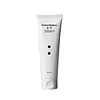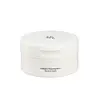What's inside
What's inside
 Key Ingredients
Key Ingredients

 Benefits
Benefits

 Concerns
Concerns

 Ingredients Side-by-side
Ingredients Side-by-side

Ethylhexyl Palmitate
EmollientTriethylhexanoin
MaskingGlycerin
HumectantCoco-Caprylate/Caprate
EmollientWater
Skin ConditioningPolyglyceryl-10 Myristate
Skin ConditioningKaolin
AbrasiveCaprylic/Capric Triglyceride
MaskingCentella Asiatica Extract
CleansingLaminaria Japonica Extract
Skin ProtectingEclipta Prostrata Leaf Extract
Skin ConditioningElaeis Guineensis Oil
EmollientSodium Hyaluronate
HumectantHydrogenated Lecithin
EmulsifyingSucrose Stearate
EmollientSucrose Laurate
EmollientSucrose Myristate
EmollientPentaerythrityl Tetra-Di-T-Butyl Hydroxyhydrocinnamate
AntioxidantButylene Glycol
HumectantHydrolyzed Hyaluronic Acid
HumectantDimethylsilanol Hyaluronate
HumectantDipropylene Glycol
HumectantHydrolyzed Sodium Hyaluronate
Skin ConditioningPotassium Hyaluronate
Skin ConditioningHyaluronic Acid
HumectantSodium Hyaluronate Crosspolymer
HumectantHydroxypropyltrimonium Hyaluronate
Sodium Hyaluronate Dimethylsilanol
HumectantSodium Acetylated Hyaluronate
HumectantFructooligosaccharides
HumectantBeta-Glucan
Skin Conditioning1,2-Hexanediol
Skin ConditioningEthylhexyl Palmitate, Triethylhexanoin, Glycerin, Coco-Caprylate/Caprate, Water, Polyglyceryl-10 Myristate, Kaolin, Caprylic/Capric Triglyceride, Centella Asiatica Extract, Laminaria Japonica Extract, Eclipta Prostrata Leaf Extract, Elaeis Guineensis Oil, Sodium Hyaluronate, Hydrogenated Lecithin, Sucrose Stearate, Sucrose Laurate, Sucrose Myristate, Pentaerythrityl Tetra-Di-T-Butyl Hydroxyhydrocinnamate, Butylene Glycol, Hydrolyzed Hyaluronic Acid, Dimethylsilanol Hyaluronate, Dipropylene Glycol, Hydrolyzed Sodium Hyaluronate, Potassium Hyaluronate, Hyaluronic Acid, Sodium Hyaluronate Crosspolymer, Hydroxypropyltrimonium Hyaluronate, Sodium Hyaluronate Dimethylsilanol, Sodium Acetylated Hyaluronate, Fructooligosaccharides, Beta-Glucan, 1,2-Hexanediol
Cetyl Ethylhexanoate
EmollientCaprylic/Capric Triglyceride
MaskingPEG-20 Glyceryl Triisostearate
EmollientSynthetic Wax
AbrasivePEG-10 Isostearate
EmulsifyingLactobacillus/Soybean Ferment Extract
Skin ConditioningHippophae Rhamnoides Oil
EmollientOryza Sativa Bran Oil
EmollientOryza Sativa Seed Water
AntimicrobialAvena Sativa Meal Extract
SoothingCoix Lacryma-Jobi Ma-Yuen Seed Extract
Skin ConditioningOryza Sativa Extract
AbsorbentWater
Skin ConditioningSorbitan Sesquioleate
EmulsifyingGlycerin
HumectantPropanediol
SolventButylene Glycol
Humectant1,2-Hexanediol
Skin ConditioningCaprylyl Glycol
EmollientEthylhexylglycerin
Skin ConditioningCetyl Ethylhexanoate, Caprylic/Capric Triglyceride, PEG-20 Glyceryl Triisostearate, Synthetic Wax, PEG-10 Isostearate, Lactobacillus/Soybean Ferment Extract, Hippophae Rhamnoides Oil, Oryza Sativa Bran Oil, Oryza Sativa Seed Water, Avena Sativa Meal Extract, Coix Lacryma-Jobi Ma-Yuen Seed Extract, Oryza Sativa Extract, Water, Sorbitan Sesquioleate, Glycerin, Propanediol, Butylene Glycol, 1,2-Hexanediol, Caprylyl Glycol, Ethylhexylglycerin
 Reviews
Reviews

Ingredients Explained
These ingredients are found in both products.
Ingredients higher up in an ingredient list are typically present in a larger amount.
1,2-Hexanediol is a synthetic liquid and another multi-functional powerhouse.
It is a:
- Humectant, drawing moisture into the skin
- Emollient, helping to soften skin
- Solvent, dispersing and stabilizing formulas
- Preservative booster, enhancing the antimicrobial activity of other preservatives
Butylene Glycol (or BG) is used within cosmetic products for a few different reasons:
Overall, Butylene Glycol is a safe and well-rounded ingredient that works well with other ingredients.
Though this ingredient works well with most skin types, some people with sensitive skin may experience a reaction such as allergic rashes, closed comedones, or itchiness.
Learn more about Butylene GlycolThis ingredient is an emollient, solvent, and texture enhancer. It is considered a skin-softener by helping the skin prevent moisture loss.
It helps thicken a product's formula and makes it easier to spread by dissolving clumping compounds.
Caprylic Triglyceride is made by combining glycerin with coconut oil, forming a clear liquid.
While there is an assumption Caprylic Triglyceride can clog pores due to it being derived from coconut oil, there is no research supporting this.
Learn more about Caprylic/Capric TriglycerideGlycerin is already naturally found in your skin. It helps moisturize and protect your skin.
A study from 2016 found glycerin to be more effective as a humectant than AHAs and hyaluronic acid.
As a humectant, it helps the skin stay hydrated by pulling moisture to your skin. The low molecular weight of glycerin allows it to pull moisture into the deeper layers of your skin.
Hydrated skin improves your skin barrier; Your skin barrier helps protect against irritants and bacteria.
Glycerin has also been found to have antimicrobial and antiviral properties. Due to these properties, glycerin is often used in wound and burn treatments.
In cosmetics, glycerin is usually derived from plants such as soybean or palm. However, it can also be sourced from animals, such as tallow or animal fat.
This ingredient is organic, colorless, odorless, and non-toxic.
Glycerin is the name for this ingredient in American English. British English uses Glycerol/Glycerine.
Learn more about GlycerinWater. It's the most common cosmetic ingredient of all. You'll usually see it at the top of ingredient lists, meaning that it makes up the largest part of the product.
So why is it so popular? Water most often acts as a solvent - this means that it helps dissolve other ingredients into the formulation.
You'll also recognize water as that liquid we all need to stay alive. If you see this, drink a glass of water. Stay hydrated!
Learn more about Water